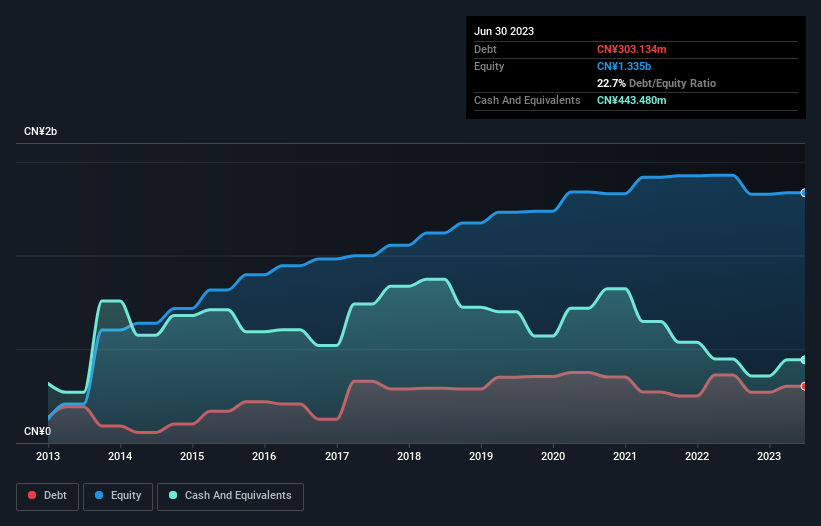
The external fund manager backed by Berkshire Hathaway's Charlie Munger, Li Lu, makes no bones about it when he says 'The biggest investment risk is not the volatility of prices, but whether you will suffer a permanent loss of capital.' So it seems the smart money knows that debt - which is usually involved in bankruptcies - is a very important factor, when you assess how risky a company is. We note that Cabbeen Fashion Limited (HKG:2030) does have debt on its balance sheet. But should shareholders be worried about its use of debt?
When Is Debt Dangerous?
Debt and other liabilities become risky for a business when it cannot easily fulfill those obligations, either with free cash flow or by raising capital at an attractive price. If things get really bad, the lenders can take control of the business. However, a more usual (but still expensive) situation is where a company must dilute shareholders at a cheap share price simply to get debt under control. Having said that, the most common situation is where a company manages its debt reasonably well - and to its own advantage. The first thing to do when considering how much debt a business uses is to look at its cash and debt together.
See our latest analysis for Cabbeen Fashion
What Is Cabbeen Fashion's Net Debt?
The image below, which you can click on for greater detail, shows that Cabbeen Fashion had debt of CN¥303.1m at the end of June 2023, a reduction from CN¥362.4m over a year. However, its balance sheet shows it holds CN¥443.5m in cash, so it actually has CN¥140.3m net cash.

A Look At Cabbeen Fashion's Liabilities
We can see from the most recent balance sheet that Cabbeen Fashion had liabilities of CN¥857.7m falling due within a year, and liabilities of CN¥24.0m due beyond that. Offsetting this, it had CN¥443.5m in cash and CN¥674.6m in receivables that were due within 12 months. So it can boast CN¥236.3m more liquid assets than total liabilities.
This surplus liquidity suggests that Cabbeen Fashion's balance sheet could take a hit just as well as Homer Simpson's head can take a punch. With this in mind one could posit that its balance sheet means the company is able to handle some adversity. Simply put, the fact that Cabbeen Fashion has more cash than debt is arguably a good indication that it can manage its debt safely. The balance sheet is clearly the area to focus on when you are analysing debt. But it is Cabbeen Fashion's earnings that will influence how the balance sheet holds up in the future. So if you're keen to discover more about its earnings, it might be worth checking out this graph of its long term earnings trend.
Over 12 months, Cabbeen Fashion made a loss at the EBIT level, and saw its revenue drop to CN¥1.2b, which is a fall of 12%. That's not what we would hope to see.
So How Risky Is Cabbeen Fashion?
While Cabbeen Fashion lost money on an earnings before interest and tax (EBIT) level, it actually generated positive free cash flow CN¥55m. So although it is loss-making, it doesn't seem to have too much near-term balance sheet risk, keeping in mind the net cash. There's no doubt the next few years will be crucial to how the business matures. The balance sheet is clearly the area to focus on when you are analysing debt. But ultimately, every company can contain risks that exist outside of the balance sheet. For instance, we've identified 2 warning signs for Cabbeen Fashion (1 is a bit unpleasant) you should be aware of.
When all is said and done, sometimes its easier to focus on companies that don't even need debt. Readers can access a list of growth stocks with zero net debt 100% free, right now.
New: AI Stock Screener & Alerts
Our new AI Stock Screener scans the market every day to uncover opportunities.
• Dividend Powerhouses (3%+ Yield)
• Undervalued Small Caps with Insider Buying
• High growth Tech and AI Companies
Or build your own from over 50 metrics.
Have feedback on this article? Concerned about the content? Get in touch with us directly. Alternatively, email editorial-team (at) simplywallst.com.
This article by Simply Wall St is general in nature. We provide commentary based on historical data and analyst forecasts only using an unbiased methodology and our articles are not intended to be financial advice. It does not constitute a recommendation to buy or sell any stock, and does not take account of your objectives, or your financial situation. We aim to bring you long-term focused analysis driven by fundamental data. Note that our analysis may not factor in the latest price-sensitive company announcements or qualitative material. Simply Wall St has no position in any stocks mentioned.
About SEHK:2030
Cabbeen Fashion
A fashion casual menswear company, designs and retails apparel, shoes, and accessories for men, women, and kids under the Cabbeen, Cabbeen Lifestyle, Cabbeen Urban, Cabbeen Love, and 2AM brands in the People’s Republic of China.
Flawless balance sheet with questionable track record.

